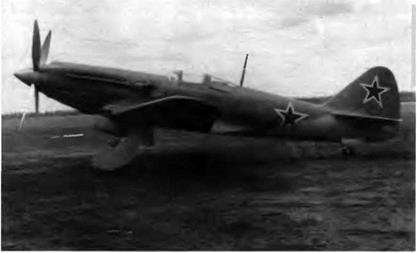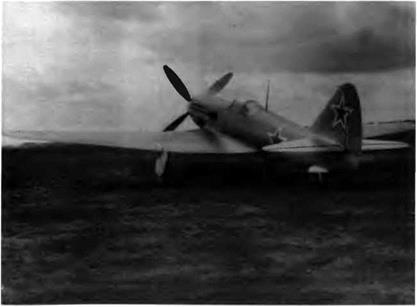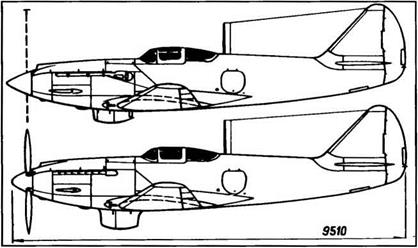1-222 / ЗА
The third series-A high-altitude interceptor received the provisional designation of 1-222 Like the 1-221, its cockpit was pressurized and air – conditioned The aft-sliding canopy was fitted with an inflatable seal bead The fuselage decking behind the cockpit was cut down to improve the pilot’s rear vision. The rear fuselage and outer wing panel structure reverted to wood while the front fuselage, wing center section, flying controls, and flaps remained metallic. The engine coolant radiator and the oil cooler were both located in the leading edge of the wing center section, and the heat exchanger was placed in a ventral bath beneath the back of the engine Flexible fuel tanks were housed in the wing center section, and the oil tank was incorporated into the wing leading edge The tailplane area (3 34 m2 [35 95 square feet]) and tail fin area (2 01 m2 [21.6 square feet]) were slightly larger than those of the 1-221. Tire sizes were 650 x 200 for the main gear and 350 x 125 for the tail wheel.
The 1-222 was powered by an AM-39B-1 (still under development then) with an experimental exhaust-driven TK-300B turbo-supercharger on the right side of the engine It afforded 1,288 kW (1,750 ch) at takeoff, 1,104 kW (1,500 ch) at 5,850 m (19,200 feet) and 1,052 kW (1,430 ch) at 13,200 m (43,300 feet), driving a four-bladed AV-9L-26 propeller (three-bladed at first) specially designed for high-altitude flight. The 1-222 also featured an engine-driven centrifugal compressor (PTsN) to raise the engine rated altitude. The entire engine weighed

|

|
1-222 (ЗА) and 1-224 (4А) (MiG ОКБ drawing) |
1,845 kg (4,066 pounds): 85 kg (187 pounds) for the turbo-supercharger, 190 kg (419 pounds) for the propeller, 128 kg (282 pounds) for the radiator and its glycol, 80 kg (176 pounds) for the heat exchanger, 65 kg (143 pounds) for the oil cooler, 10.5 kg (23 pounds) for the oil tank, 12 kg (26 pounds) for the piping, 23 kg (51 pounds) for the exhaust pipes, and 30 kg (66 pounds) for the engine mount.
In the cockpit, the pilot was protected by an armored seat back, a bulletproof windscreen, and rear glazing. The aircraft’s armament comprised two synchronized 20-mm ShVAK cannons (80 rpg) flanking the engine. The 1-222 left the factory on 23 April 1944 and was first flown by A. I. Zhukov on 7 May. The aircraft rapidly proved to be capable of outstanding performance with a top speed of 691 km/h (373 kt) and a 14,500 m (47,560 feet) ceiling—record-setting figures at the time for this category of aircraft. But the 1-222 had no future because by the time it was ready the German high-altitude reconnaissance flights over the Moscow area had stopped. The air defense regiments no longer needed this type of aircraft.
Specifications
Span, 13 m (42 ft 7.8 in); length, 9.608 m (31 ft 6.1 in); wheel track, 3.516 m (11 ft 6.4 in); wheel base, 5.85 m (19 ft 2.3 in); wing area, 22.44 mz (241.5 sq ft); empty weight, 3,167 kg (6,980 lb); takeoff weight, 3,790 kg (8,353 lb); fuel, 300 kg (660 lb); oil, 40 kg (88 lb); wing loading, 168.9 kg/mz (34.6 lb/sq ft).
Performance
Max speed, 682 km/h at 6,700 m (368 kt at 21,975 ft); 691 km/h at 12,500 m (373 kt at 41,000 ft); climb to 5,000 m (16,400 ft) in 6 min; service ceiling, 14,500 m (47,560 ft); landing speed, 169 km/h (91 kt); range, 1,000 km (620 mi).











